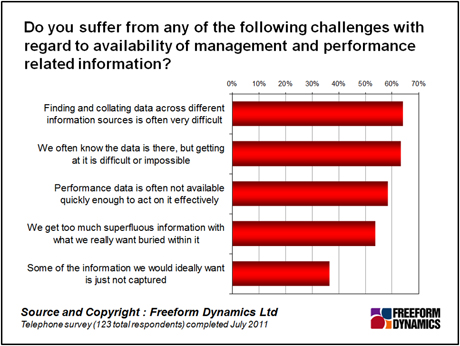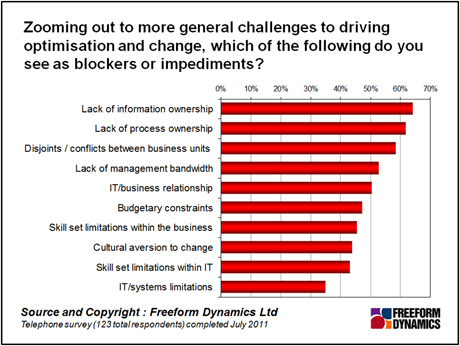Business must be ready to respond to rapidly changing market conditions. For any organisation to be able to react rapidly there is a clear requirement for the devolution of decision making to local managers. This in turn places considerable pressure on IT to ensure local managers have all the information they require to act independently at their fingertips.
This is no easy problem to address and puts CIOs under great pressure as modifying IT systems to deliver new services can be complex and time consuming. To help IT respond rapidly to change, considerable attention has already been paid by large and mid-sized organisations to areas such as data centre consolidation, server and storage virtualisation and various approaches to cloud computing.
Yet when it comes to the information itself, our research, of line of business managers, shows that data fragmentation and difficulty finding information are highlighted as major impediments to effective decision making. Getting hold of the information required to make decisions and run the business can consume considerable effort (Figure 1).

Figure 1
The research revealed organisations that are able to effectively utilise key performance indicators generally outperform their peers. But making sure everyone in the management structure has access to the data they need is by no means straightforward in distributed environments.
Whilst improvements in IT capabilities can assist in making information easier for business managers to get hold of, technology solutions alone can only deliver so much. Operational processes, both within IT and in line of business units, need to be modified in step with IT investments for the organisation to maximise benefits.
At a technology level, the CIO may wish to develop advanced capabilities in areas such ‘master data management’ (MDM), data integration and data ‘cleansing’ to help reduce the need for data reconciliation between sources. Beyond this, solutions including centralised content management may also assist line managers to make better real time decisions as delegation of action spreads through the organisation.
But getting different data sources, even in a small business, to agree with each other in terms of format and, more importantly content, is a complex task. Data reconciliation essentially relies on people making choices. In most large organisations multiple departments may each hold fragments of information that needs to be assembled and manipulated by managers in order to be useful for making timely decisions.
But getting each department to agree whose data is most accurate or which format should be adopted across the business is certain to involve a degree of internal politics as well as high level interpersonal ‘information exchange’. Unless the problem of fragmented data and process ‘ownership’ within the business is tackled, improvement will be constrained by political barriers, and any progress is likely to be constrained if existing data management practices and ownership models are perpetuated. Simply getting line of business managers to agree on who ‘owns’ the data in the first place can be a challenge (Figure 2).

Figure 2
This illustrates just how big an issue the lack of ownership of information and business processes is. It is worthwhile noting that figure 2 records the views of senior business managers rather than those working in IT. From the chart it is clear that these ownership issues are widely recognised and they are frequently far bigger inhibitors to organisational change and agility than issues with IT itself.
As a consequence, it is also obvious that this is a challenge that IT cannot address alone, even though in most businesses ‘looking after data’ is often subconsciously delegated to IT. This can further stress IT staff and CIOs as they may be compelled to make decisions on data matters which really require line of business input and knowledge.
So what can the CIO do in the face of all these ‘people’ problems? The first step, not unnaturally, is to accept that the challenges exist and getting the senior management team to recognise that this matters to the health of the business. The last things any CIO should want is to have the business pass responsibility for data ownership to IT without business managers taking ownership of key decisions on data management. This approach inevitably leads to issues as IT rarely has a full understanding of the business context and value of all sources of data held in the company.
An obvious next step is then to build an information architecture group with authority delegated by executive management. The group’s function should be to develop and maintain over time a strategic understanding of the organisation’s data and information requirements. It would also seek to ensure that information resources are built efficiently and utilised effectively whenever new
projects arise. This will take time and effort, and require a lot of people working together, but the business benefits are potentially huge.
CLICK HERE TO VIEW ORIGINAL PUBLISHED ON

Tony is an IT operations guru. As an ex-IT manager with an insatiable thirst for knowledge, his extensive vendor briefing agenda makes him one of the most well informed analysts in the industry, particularly on the diversity of solutions and approaches available to tackle key operational requirements. If you are a vendor talking about a new offering, be very careful about describing it to Tony as ‘unique’, because if it isn’t, he’ll probably know.





Have You Read This?
From Barcode Scanning to Smart Data Capture
Beyond the Barcode: Smart Data Capture
The Evolving Role of Converged Infrastructure in Modern IT
Evaluating the Potential of Hyper-Converged Storage
Kubernetes as an enterprise multi-cloud enabler
A CX perspective on the Contact Centre
Automation of SAP Master Data Management
Tackling the software skills crunch